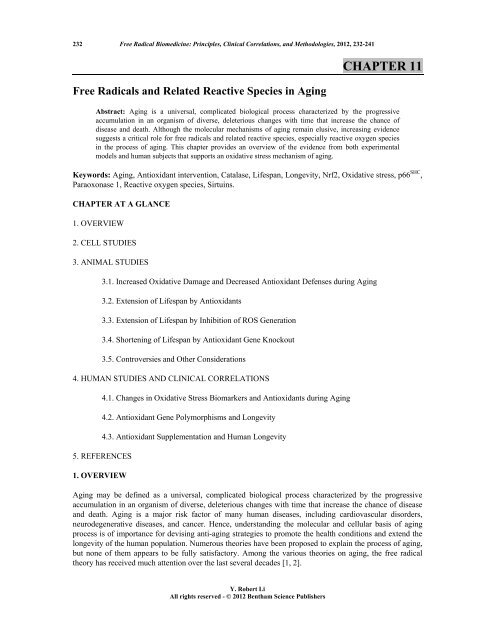Free Radical Biomedicine: Principles, Clinical ... - Bentham Science
Free Radical Biomedicine: Principles, Clinical ... - Bentham Science
Free Radical Biomedicine: Principles, Clinical ... - Bentham Science
You also want an ePaper? Increase the reach of your titles
YUMPU automatically turns print PDFs into web optimized ePapers that Google loves.
232 <strong>Free</strong> <strong>Radical</strong> <strong>Biomedicine</strong>: <strong>Principles</strong>, <strong>Clinical</strong> Correlations, and Methodologies, 2012, 232-241<br />
<strong>Free</strong> <strong>Radical</strong>s and Related Reactive Species in Aging<br />
Y. Robert Li<br />
All rights reserved - © 2012 <strong>Bentham</strong> <strong>Science</strong> Publishers<br />
CHAPTER 11<br />
Abstract: Aging is a universal, complicated biological process characterized by the progressive<br />
accumulation in an organism of diverse, deleterious changes with time that increase the chance of<br />
disease and death. Although the molecular mechanisms of aging remain elusive, increasing evidence<br />
suggests a critical role for free radicals and related reactive species, especially reactive oxygen species<br />
in the process of aging. This chapter provides an overview of the evidence from both experimental<br />
models and human subjects that supports an oxidative stress mechanism of aging.<br />
Keywords: Aging, Antioxidant intervention, Catalase, Lifespan, Longevity, Nrf2, Oxidative stress, p66 SHC ,<br />
Paraoxonase 1, Reactive oxygen species, Sirtuins.<br />
CHAPTER AT A GLANCE<br />
1. OVERVIEW<br />
2. CELL STUDIES<br />
3. ANIMAL STUDIES<br />
3.1. Increased Oxidative Damage and Decreased Antioxidant Defenses during Aging<br />
3.2. Extension of Lifespan by Antioxidants<br />
3.3. Extension of Lifespan by Inhibition of ROS Generation<br />
3.4. Shortening of Lifespan by Antioxidant Gene Knockout<br />
3.5. Controversies and Other Considerations<br />
4. HUMAN STUDIES AND CLINICAL CORRELATIONS<br />
4.1. Changes in Oxidative Stress Biomarkers and Antioxidants during Aging<br />
4.2. Antioxidant Gene Polymorphisms and Longevity<br />
4.3. Antioxidant Supplementation and Human Longevity<br />
5. REFERENCES<br />
1. OVERVIEW<br />
Aging may be defined as a universal, complicated biological process characterized by the progressive<br />
accumulation in an organism of diverse, deleterious changes with time that increase the chance of disease<br />
and death. Aging is a major risk factor of many human diseases, including cardiovascular disorders,<br />
neurodegenerative diseases, and cancer. Hence, understanding the molecular and cellular basis of aging<br />
process is of importance for devising anti-aging strategies to promote the health conditions and extend the<br />
longevity of the human population. Numerous theories have been proposed to explain the process of aging,<br />
but none of them appears to be fully satisfactory. Among the various theories on aging, the free radical<br />
theory has received much attention over the last several decades [1, 2].

















